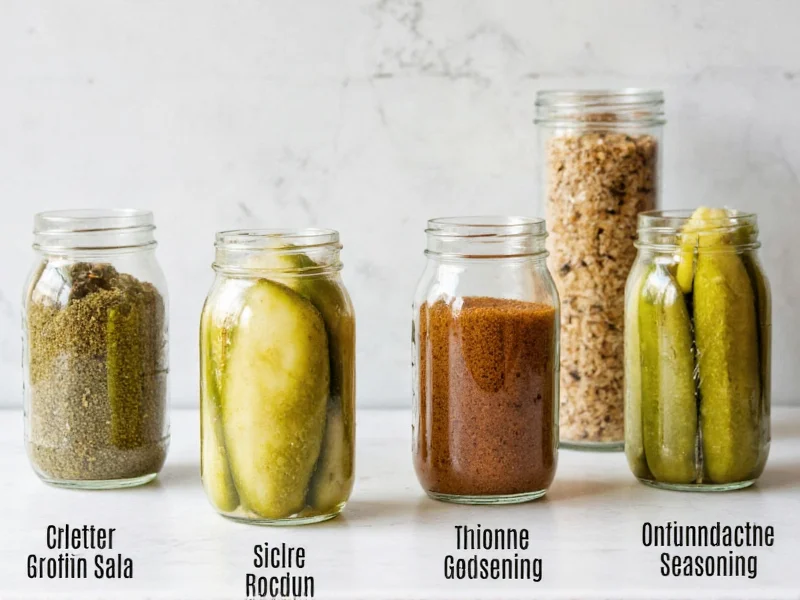Create Exceptional Pickle Seasoning at Home
Homemade pickle seasoning transforms ordinary cucumbers into restaurant-quality pickles with complex flavors you can't achieve with store-bought mixes. Unlike commercial blends that often contain fillers and artificial ingredients, crafting your own pickle spice blend gives you complete control over flavor intensity and ingredient quality. The best pickle seasoning recipes balance aromatic spices with the right acid-to-salt ratio for optimal crunch and taste.
Why Homemade Pickle Seasoning Beats Store-Bought
Commercial pickle seasoning packets frequently contain anti-caking agents, preservatives, and inconsistent spice blends. When you make your own homemade dill pickle seasoning recipe, you avoid unnecessary additives while customizing flavors to your preference. Freshly ground spices release more essential oils, creating brighter, more vibrant pickle flavors that mellow beautifully during the curing process. Plus, creating your own authentic kosher dill seasoning mix costs significantly less per batch than premium store varieties.
Three Essential Pickle Seasoning Variations
Master these three foundational recipes to cover all your pickling needs. Each blend uses whole spices for superior flavor extraction compared to pre-ground alternatives.
| Seasoning Type | Core Ingredients | Best For | Brine Ratio (per 5 lbs cucumbers) |
|---|---|---|---|
| Classic Dill | Dill seed, mustard seed, coriander, garlic, bay leaves | Crisp refrigerator or fermented pickles | 4 cups vinegar, 2 cups water, 1/4 cup pickling salt |
| Bread & Butter | Celery seed, turmeric, mustard seed, onion, cinnamon | Sweet sandwich slices and relishes | 3 cups vinegar, 2 cups sugar, 1 cup water, 2 tbsp salt |
| Spicy Garlic | Garlic cloves, red pepper flakes, black peppercorns, oregano | Quick pickled vegetables and cocktail onions | 3 cups vinegar, 1 cup water, 3 tbsp salt, 1/4 cup sugar |
Perfecting Your Pickle Seasoning Technique
For the best bread and butter pickle seasoning, toast whole mustard and celery seeds in a dry skillet for 2-3 minutes until fragrant before measuring. This simple step dramatically enhances flavor complexity. Always use pickling or canning salt rather than table salt, which contains iodine that can darken pickles and anti-caking agents that cloud brine.
When preparing simple refrigerator pickle seasoning, layer half your spices in the bottom of each jar and the other half on top of your vegetables. This creates even flavor distribution as the brine circulates. For fermented pickles, use 1 tablespoon of your seasoning blend per quart of brine solution.
Advanced Pickle Seasoning Tips
Experiment with these professional techniques to elevate your homemade pickles:
- Add 1/4 teaspoon grapefruit seed extract to maintain crunch without calcium chloride
- Include fresh dill flower heads for authentic deli-style flavor
- Use white wine vinegar for delicate vegetables, apple cider vinegar for robust flavors
- Store dried seasoning blends in amber glass jars away from light for maximum freshness
Creative Uses for Pickle Seasoning Beyond Cucumbers
Your homemade pickle mix works wonders with other vegetables too. Try these applications:
- Toss cauliflower florets with pickle seasoning and roast for tangy snacks
- Add 1 tablespoon to potato salad dressing for extra dimension
- Infuse olive oil with pickle spices for vibrant salad dressings
- Season roasted carrots with dill pickle blend for unexpected sweetness
Troubleshooting Common Pickle Problems
Soft pickles? Ensure you're using fresh, firm cucumbers and include tannin-rich elements like oak leaves or grape leaves in each jar. Cloudy brine typically indicates hard water minerals—switch to distilled water. If your pickle spice blend measurements seem off, remember that spice potency varies by harvest year; adjust incrementally in future batches rather than altering current brine.











 浙公网安备
33010002000092号
浙公网安备
33010002000092号 浙B2-20120091-4
浙B2-20120091-4